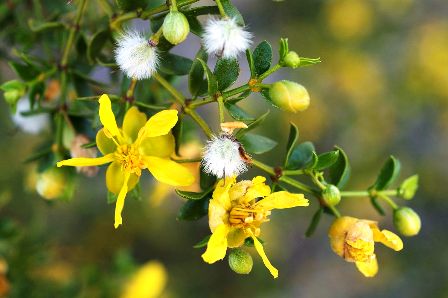Eating that Can Result in Starvation
Psalm 102:5-6
“By reason of the voice of my groaning my bones cleave to my skin. I am like a pelican of the wilderness: I am like an owl of the desert.”
The creosote shrub is common in the desert of the American Southwest and northern Mexico. This remarkable plant is not only well designed for life in the desert, but also it protects itself from those who would munch on its leaves.
 Creosote bushes grow in stands because they reproduce by sending shoots out from a collective root system. One stand measured over 60 feet across at its widest point! Stands can be hundreds of years old. The bushes produce several hundred chemicals that evaporate into the air. Stands are said to smell like chemistry laboratories. Other desert plants avoid growing near them, probably because of the smell. As a result, stands do not have to share scarce water supplies with other plants. Compounds called phenols and phenoloxidasa are among the chemicals produced by the leaves. These chemicals must be stored in different compartments within the leaves so that they do not react with each other. However, when the leaves are chewed, these compartments break down. They react in the stomach, producing chemicals called quinones. The quinones then react with the plant proteins, changing them into a form that cannot be digested. The result is that whatever tries to eat creosote leaves can have a full stomach and be starving at the same time!
Creosote bushes grow in stands because they reproduce by sending shoots out from a collective root system. One stand measured over 60 feet across at its widest point! Stands can be hundreds of years old. The bushes produce several hundred chemicals that evaporate into the air. Stands are said to smell like chemistry laboratories. Other desert plants avoid growing near them, probably because of the smell. As a result, stands do not have to share scarce water supplies with other plants. Compounds called phenols and phenoloxidasa are among the chemicals produced by the leaves. These chemicals must be stored in different compartments within the leaves so that they do not react with each other. However, when the leaves are chewed, these compartments break down. They react in the stomach, producing chemicals called quinones. The quinones then react with the plant proteins, changing them into a form that cannot be digested. The result is that whatever tries to eat creosote leaves can have a full stomach and be starving at the same time!
The creosote’s advanced chemical warfare could not possibly be a product of mindless evolution. Its methods of protection reveal a well thought out design that can only be credited to a wise Creator.
Prayer:
Dear Father, in Christ I flee to You from the desert of my guilt. Amen.
Notes:
Bombardier Beetles and Fever Trees, pp. 25-27. Photo: Creosote bush, Death Valley National Park, California. Courtesy of Eric in SF. (CC-BY-SA 3.0)